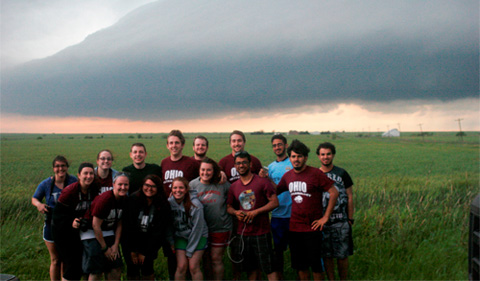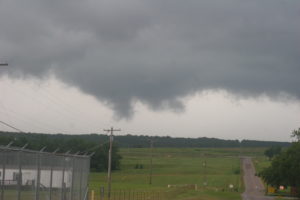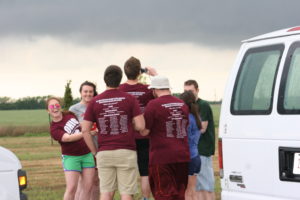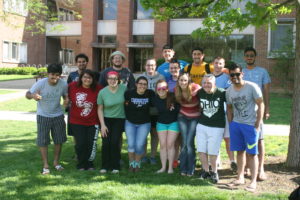
Dr. Jana Houser led 12 undergraduates and two graduates on a storm-chasing trek through the Central Plains.
by Kristin M. Distel
Dr. Jana Houser, Assistant Professor of Geography, led a group of students on a rare and exciting adventure in May. She and her team of students spent a week in the Central Plains, where they chased supercell thunderstorms and tornadoes.
The team saw tornadoes on their very first day of chasing.
Twelve undergraduates and two graduate students joined Houser on a trek of 4,318 miles through Kansas, Oklahoma, and Texas, where they tracked weather patterns and gained valuable skills in weather predictions and meteorology.
“This was hands down one of the best experiences of my life, and I am very thankful that Dr. Houser was able to arrange this and put us in good positions each day to chase the storms,” says Michael Sparer, one of Houser’s undergraduates.

Houser’s students encountered two tornadoes on their first day of chasing.
“No students had seen tornadoes before,” Houser explains, “so that was particularly exhilarating.” The tornadoes appeared in a field, so there was no imminent danger to life or property. “It was especially memorable to see students’ excitement and engagement with topics we talked about in classroom.”
Student Sara Marzola recalls the excitement of seeing for herself the types of storms the class had learned about in Houser’s lectures.
“I will never forget my first day of actual storm chasing,” Marzola explains. “This is the day where I saw two tornadoes, which were cyclic tornadoes from the same supercell, and an amazing supercell structure that unfortunately did not produce a tornado. While seeing the tornadoes in person made me speechless, it was my professor calling the National Weather Service and reporting the tornado production that brought me back to reality. Dr. Houser called in to inform the NWS about the tornadic threat in our area so that they could get the warning out to the public as soon as possible; this made me realize that this is what storm chasing is all about.”
Overcoming Obstacles
Choosing a storm to chase, Houser explains, was challenging because many storms occurred early in the day, before the group properly positioned for that day’s storm-chasing.
“For our purposes,” she notes, “it is ideal when a storm occurs in the middle of the afternoon. This maximizes the amount of instability in the atmosphere, which allows storms to be more explosive and intense.”

One of the many storms Houser’s group chased in the Central Plains
Another complication arose from the sheer number of storms in a single region. Determining which storm would have the greatest likelihood of producing a tornado with good visibility required a great deal of consideration and planning.
“It was difficult,” Houser says, “when there were six storms in the same area.” Their endeavors were further hampered by heavy rain surrounding the storms, which impeded their ability to visually observe tornadoes and even caused roads to flood. The group encountered an additional eight tornadoes that they could not see because of downpours in the area.
Choosing a Storm to Chase
Each night the group had a briefing that examined the weather forecast models and projected storm locations for the following day, discussing the benefits and drawbacks of the various regions in which storms could potentially occur. The following morning, the group met again to reevaluate the forecast from the previous night.

Houser’s team heading out for a day of storm-chasing
“We had to consider whether the initial target location still seemed viable,” Houser notes. “The students participated in this process and helped determine a target location.” After finalizing a site, the team usually left at 10:30 a.m. for their intended location, which was generally several hours away.
“About 75 percent of the time new observations and predictions came out, and we had to choose a new target location at lunchtime,” says Houser. “The actual process of chasing required us to be flexible and dynamic. Ideally, we put ourselves into position before the storms fired, and we waited for them to begin. In order to do this, we had to make fast-paced decisions.”
‘Seeing Course Lessons in Action with Their Own Eyes’
The most significant benefit of the storm-chasing trip, Houser remarks, is the chance to take classroom concepts and apply them in the field. “Students learned why some of the environmental parameters we talked about in class were so important. The trip is an application of course-based material to a real-world scenario. They are seeing course lessons in action with their own eyes.”
Houser’s students agree, especially Michael Outrich, who describes the unforgettable nature of the team’s adventure.
“I truly learned a ton on this trip,” Outrich states, “and I am very grateful to have had Dr. Houser lead the course. I’ve learned more from this class in a week than I would’ve learned in a semester, and I had a blast doing it.”

Houser’s students chased many storms that provided useful storm data
Safety and Preparedness
Safety, of course, is a primary concern for Houser and the team. Students attend three preparatory sessions before leaving: one on overall expectations for the trip, one on safety, and one more on road conditions during a storm.
“Driving safely is something we emphasize, including maintaining a safe speed and especially being wary of what their surroundings are when they are looking at a storm. When they are parked and collecting data, chasers need to remember that they are close to the road. There is a tendency to forget your surroundings when you’re looking up at a storm.”
Houser also discussed with students other potentially dangerous situations, especially pockets of hail. Additionally, Houser instituted a buddy system. Each student was assigned a teammate with whom he or she shared a room and partnered with in the travel vans. The system ensured that no one was left behind or endangered.

Houser’s students prepare for a day of storm-chasing
Interested students were also required to complete a seminar focusing on supercell thunderstorm and tornado structure, evolution, formation, and environments, or a class in mesoscale meteorology. The purpose of this prerequisite, Houser explains, is to further familiarize students with smaller scale weather processes that they would later encounter in their storm-chasing adventure.
Preparation for Grad School and the Job Market
The storm-chasing trip was invaluable in preparing students for their respective careers, Houser explains. Several of the participants have entered the field of broadcast meteorology, while others went into graduate school. Still others have found work in the private sector with corporations that require on-staff meteorologists. “Our trip will be valuable for all of them in different ways,” says Houser.

The team members have since found jobs in broadcast meteorology, begun graduate school, and entered the private sector
Regardless of the fields they have entered, Houser notes, “The trip helped them develop a greater understanding and appreciation for the dynamic nature of the atmosphere and for its grandeur and unpredictability. They all gained insight into how forecasting is an imprecise science.”
Houser will lead another group of students on a storm-chasing trek across the Central Plains in 2017. Houser emphasizes that prospective students should consider the unique field experience that this trip can provide. “It’s an experience that can’t be gained in a classroom. It’s a once in a lifetime adventure.”
Nick Wolanczyk, one of the students who participated in the trip, concurs: “This trip was an unreal experience for me and the other students who participated. For some this was possibly even a once in a lifetime experience. Being able to see these storms in person was far more exciting than I had ever imagined.”


















Comments